NCERT Solutions for Class 10 Science Chapter 11 Human Eye and Colourful World
These Solutions are part of NCERT Solutions for Class 10 Science. Here we have given NCERT Solutions for Class 10 Science Chapter 11 Human Eye and Colourful World. Learn Insta provides you the Free PDF download of NCERT Solutions for Class 10 Science (Physics) Chapter 11 – Human Eye and Colourful World solved by Expert Teachers as per NCERT (CBSE) Book guidelines. All Chapter 11 – Human Eye and Colourful World Exercise Questions with Solutions to help you to revise complete Syllabus and Score More marks.
NCERT Questions
In Text Book Questions
Question 1.
What is meant by power of accommodation of the eye ?
(CBSE Sample Paper 2010, 2012, 2014, 2015, 2016, 2017)
Answer:
The ability of the eye lens to adjust its focal length to see nearby and distant objects clearly.
More Resources
- NCERT Solutions for Class 10 Science
- NCERT Exemplar Solutions for Class 10 Science
- HOTS Questions for Class 10 Science
- Value Based Questions in Science for Class 10
- Previous Year Question Papers for CBSE Class 10 Science
Question 2.
A person with a myopic eye cannot see objects beyond 1.2 m distinctly. What should be the type of the corrective lens used to restore proper vision ?
Answer:

Question 3.
What is the far point and near point of the human eye with normal vision ? (CBSE 2011, 2012, 2014)
Answer:
The farthest position of an object from the human eye so that its sharp image is formed on the retina is at infinite distance from the eye.
The nearest position of an object from a human eye so that its sharp image is formed on the retina is at 25 cm from the eye.
Question 4.
A student has difficulty in reading the black board while sitting in the last row. What could be the defect the child is suffering from ? How can it be corrected ? (CBSE 2012)
Answer:
Near sightedness or myopia. This defect can be corrected by using a concave lens of suitable focal length.
NCERT Chapter End Exercises
Question 1.
Choose the correct option :
Human eye can focus objects at different distances by adjusting the focal length of the eye lens. This is due to
(a) presbyopia
(b) near sightedness
(c) accommodation
(d) far sightedness.
Answer:
(c).
Question 2.
Human eye forms the image of an object at its
(a) cornea
(b) iris
(c) pupil
(d) retina.
Answer:
(d).
Question 3.
The least distance of distinct vision for a young adult with normal vision is about (CBSE 2012, Bihar Board 2012)
(a) 25 m
(b) 2.5 cm
(c) 25 cm
(d) 50 cm. (CBSE 2011)
Answer:
(c).
Question 4.
The change in focal length of an eye lens is caused by the action of
(a) pupil
(b) retina
(c) ciliary muscles
(d) iris. (CBSE 2011)
Answer:
(c).
Question 5.
A person needs a lens of power – 5.5 diopters for correcting distant vision. For correcting his near vision, he needs a lens of power +1.5 diopter. What is the focal length of the lens required for correcting
(i) distant vision and
(ii) near vision ?
Answer:

Question 6.
The far point of a myopic person is 150 cm in front the eye. What is the nature and power of the lens required to correct the problem ?
Answer:

The lens is concave lens.
Question 7.
Make a diagram to show how hypermetropia is corrected. The near point of a hypermetropic eye is 1 m. What is the power of the lens required to correct this defect ? Assume that the near point of the normal eye is 25 cm.
(CBSE 2011)
Answer:
For diagram,
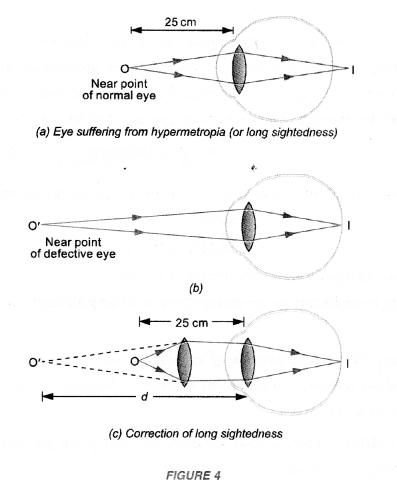

Question 8.
Why is a normal eye not able to see clearly the objects placed closer than 25 cm ? (CBSE 2011)
Answer:
The nearest position of an object from a normal human eye so that its sharp image is formed on retina is 25 cm. If the object is placed at a distance less than 25 cm, then the blurred image of the object is formed on retina as the focal length of eye lens cannot be decreased below a certain limit. Hence, eye cannot see it clearly.
Question 9.
What happens to the image distance in the eye when we increase the distance of an object from the eye ?
[CBSE (Delhi) 2008, 2011]
Answer:
The image distance remains the same in the eye because the eye has the ability to change the focal length of its lens to make the image always on the retina when the object distance increases from the eye.
Question 10.
Why do stars twinkle ? (CBSE 2011, 2012, 2015, 2016)
Or
Explain with the help of a labelled diagram, the cause of twinkling of stars. (CBSE 2014)
Answer:
Twinkling of Stars:
Light emitted by distant stars (act as point sources of light) passes through the atmosphere of the earth before reaching our eyes. The atmosphere of the earth is not uniform but consists of many layers of different densities. The layers close to the surface of the earth are optically denser. As we go higher and higher, the density of layers and refractive index decreases progressively. As the light from a star enters the uppermost layer of the atmosphere, it bends towards the normal as it enters the next layer. This process continues till the light enters our eyes. So due to refraction of light, the apparent position of the star is different from the actual position of the star (Figure 13).

Question 11.
Explain why the planets do not twinkle. (CBSE 2011, 2012, 2015)
Answer:
Planets do not twinkle:
Planets are very close to the earth as compared to the stars. The planets act as extended sources of light. So the intensity of light we receive from the planets is very large. Therefore, the variation in the brightness of the planets is not detected. Hence, planets do not twinkle.
Question 12.
Why does the Sun appear reddish early in the morning ? (CBSE 2011, 2012)
Answer:
When sunlight enters the atmosphere of the earth, the atoms and molecules of different gases present in the atmosphere absorb this light. Then these atoms and molecules of the gases re-emit light in all directions. This process is known as scattering of light. The atoms or particles scattering light are known as scatters.
The intensity of scattered light is inversely proportional to the fourth power of the wavelength of incident light, if the size of the particles (say atoms or molecules) scattering the light is less than the wavelength of the incident light.
That is, intensity of scattered light, I ∝ 1/λ4.
We know, wavelength of red light is greater than the wavelength of blue or violet light. Therefore, the intensity of scattered red light is less than the intensity of the scattered blue or violet light.
The blue colour of sky, greenish blue colour of sea water, red colour of sunset and sunrise and white colour of clouds are due to the scattering of sun light by the particles present in the atmosphere of the earth.
Question 13.
Why does the sky appear dark instead of blue to an astronaut ?
[CBSE (Delhi) 2008, 2011, 2012, CBSE (Foreign) 2016]
Or
What will the colour of the sky be for an astronaut staying in international space station orbiting the earth 1 Justify your answer giving reason. (CBSE 2014)
Answer:
The blue colour of sky is due to the scattering of sunlight. The scattering of sunlight in the atmosphere is due to the presence of atoms and molecules of gases, droplets and dust particles. When the astronaut is in space, then there is no atmosphere (or atoms and molecules of gases, droplets and dust particles) around him. Therefore, sunlight does not scatter and hence sky appears dark.
Practical Skills Based Questions ( 2 Marks)
Question 1.
Draw a path of Light ray passing through a prism.
Label angle of incidence and angle of deviation in the ray diagram. (CBSE Sample Paper 2017-18)
Answer:
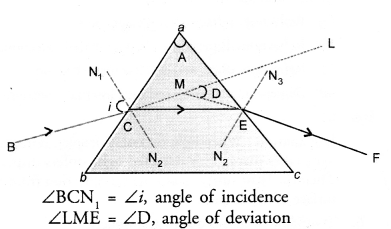
Question 2.
Draw the path of light ray passing through a glass prism. Label angle of incidence, angle of deviation and angle of emergence.
Answer:
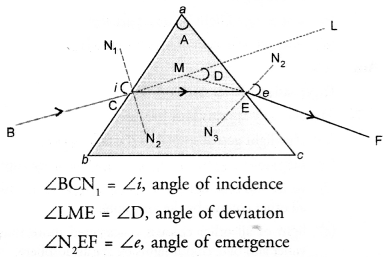
Question 3.
The path of a ray of light through a glass prism is shown below :
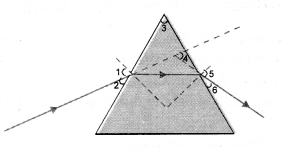
Write the names of the angles represented by 1, 3, 4 and 5 respectively.
Answer:
1. represents angle of incidence.
3. represents angle of prism.
4. represents angle of deviation
5. represents angle of emergence
Question 4.
The path of a ray of light through a glass prism is shown below :
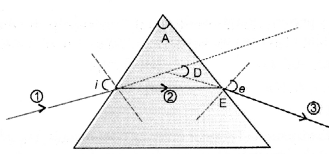
Name the incident ray of light, refracted ray of light and emergent ray of light.
Answer:
- represents incident ray of light
- represents refracted ray of light
- represents emergent ray of light
Question 5.
The path of a ray of light passing through a glass prism is shown below :
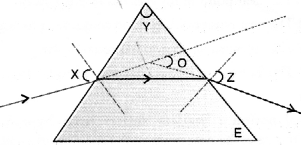
Name the angles X, Y, Z and O
Answer:
∠X = Incident angle
∠Y = Angle of prism
∠Z = Angle of emergence
∠O = Angle of deviation
Question 6.
A beam of white light falling on a glass prism gets split up into seven colours marked 1 to 7 on a screen as shown in figure.
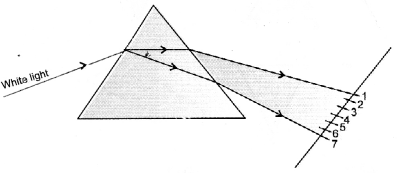
Name the colours similar to the colour of
- danger or stop signal light
- core of hard boiled egg
- colour of clear sky
- solution of potassium permanganate
Answer:
- 1 is red colour which corresponds to the colour of danger or stop signal light.
- 3 is yellow colour which corresponds to the colour of hard boiled egg.
- 5 is blue colour which corresponds to the colour of clear sky.
- 7 is violet colour which corresponds to the colour of the solution of potassium permanganate.
NCERT Solutions for Class 10 Science Chapter 11 Human Eye and Colourful World
Hope given NCERT Solutions for Class 10 Science Chapter 11 are helpful to complete your science homework.
If you have any doubts, please comment below. Learn Insta try to provide online science tutoring for you.